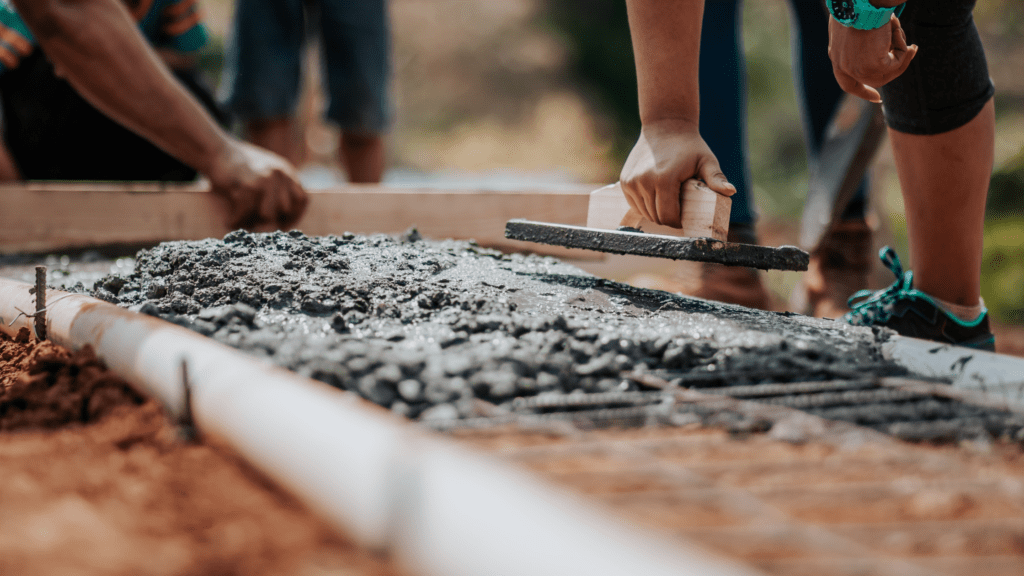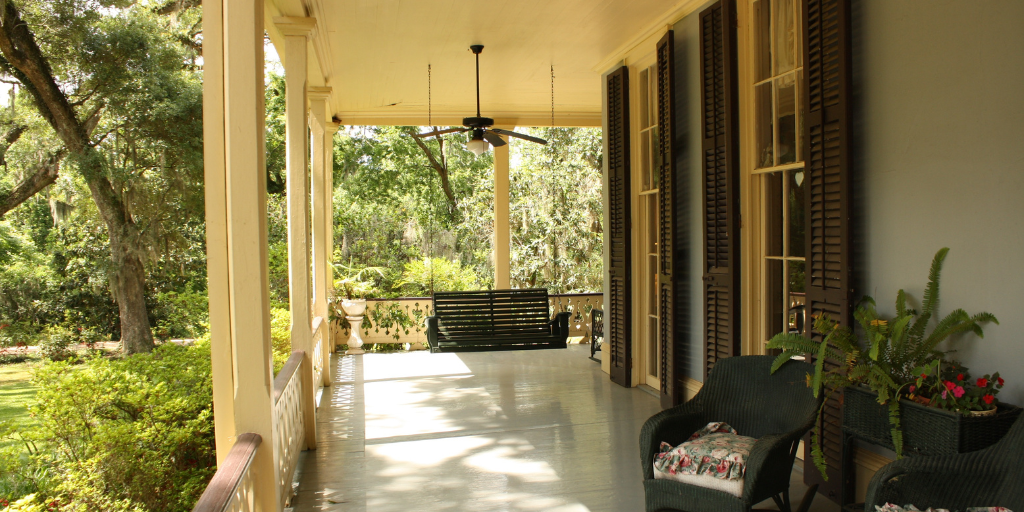There are a number of ways on how to repair a porch foundation. If your porch is starting to show signs of foundation problems, it’s important to take action right away. Foundation problems can lead to all sorts of other problems with your home, so it’s best to nip them in the bud as soon as possible. Fortunately, repairing a porch foundation is usually a relatively easy and straightforward process. We’ll walk you through everything you need to know about repairing a porch foundation.


How to Repair a Porch Foundation – Follow These Steps
Contents
- 1 How to Repair a Porch Foundation – Follow These Steps
- 2 Various Techniques on How to Repair A Porch Foundation
- 3 Slabjacking
- 4 How to Fix Porch Pulling Away From House – Injectable polymer
- 5 Pressure grouting fills voids beneath the slab
- 6 How to Fix Sinking Concrete Porch – Steel I-beams
- 7 Concrete pillars
- 8 Helical piers
- 9 PowerBraces
- 10 Porch Foundation Repair Cost
- 11 Final Thoughts on How to Repair A Porch Foundation
Foundations are a critical part of any porch, and if yours is in need of repair, it’s important to take care of the issue as soon as possible. Depending on the extent of the damage, repairing a porch foundation can be a relatively simple or complicated task. Here’s a general guide to repairing a porch foundation:
First, assess the damage to your foundation. If there are only a few cracks or crumbles, you may be able to simply patch them up with some cement. However, if the damage is more significant, you’ll need to take more drastic measures.
Next, dig out around the perimeter of your foundation to expose the damaged area. Once the damaged area is exposed, you can begin making repairs. For smaller cracks and crumbles, simply fill them in with cement. For bigger cracks, you may need to use some reinforcing rods or rebar to stabilize the area before filling it in with cement.
Once all the cracks and crumbles have been repaired, reinforce the entire perimeter of your foundation by pouring concrete around it. This will help ensure that your porch foundation is strong and durable for years to come.
Various Techniques on How to Repair A Porch Foundation


Once you understand the general idea that helps you with the necessary steps to repair your porch foundation, you have to decide which option is best for you. Below are a number of techniques you can try that will help you fix any issues you have with your porch foundation.
Some of these methods include Slabjacking, which involves removing the gap between the porch joists and the slab. Pressure grouting and injectable polymer are other methods that fill in voids beneath the slab. If none of these methods work, you can install steel I-beams to support the porch joists. The last option is recommended if you have already poured concrete on the slab.
Slabjacking
The process of slabjacking involves filling voids under the concrete slab with a grout mixture. Alternative filler materials can be used to achieve the same effect. Sand-cement grout, for example, is pumped through holes drilled in the slab. Slabjacking is a permanent solution to a gap in the slab, but it comes with its share of drawbacks.
Slabjacking is an effective way to repair settlement-related issues. Because the technique is non-invasive, minimal disruption is experienced in the house. It does not require extensive clearing of the inventory and contents. In most cases, the process can be completed in 12 hours or less. However, there are a number of important points to keep in mind before committing to this process. The first thing you should know about slab jacking is that it is not a replacement for foundation repair.
One of the most common problems with concrete foundations is soil erosion. While the problem is often unrelated to the foundation itself, it is often caused by water or ground settlement. Soil erosion is one of the main reasons for slab sinking, and Slab Jacking removes the gap between the house and the slab. However, if the ground is not well-compacted, the voids can recur. This is why the process of Slab Jacking is not recommended for houses built on concrete slabs.
How to Fix Porch Pulling Away From House – Injectable polymer
To repair a cracked porch foundation, you can use an injectable polymer to fill in voids and lift the concrete slab. The polymer expands after being injected into the foundation. The final result is a level slab that is stronger and more secure than before. During the process, you need to carefully monitor the progress of the repair. Luckily, it’s not a difficult procedure. You can even perform the repair yourself.
To fill a void beneath a porch foundation, a professional contractor needs to inject polyurethane foam. This material contains sealed gas pockets that prevent water from seeping into the slab and settling it. This two-part poly is injected through a small hole, about the size of a dime. The foam is then mechanically fastened into place with a port. When the polymer foam expands, the air bubbles in it will push up the concrete slab, lifting it and securing it in place.
The polymer stops expanding immediately after injection, and the treated area reaches 90% of its final strength in 15 minutes. An experienced technician will customize the injection process to your specific needs. A polymer injection will lift the concrete slab without lifting it, and it will stabilize the surrounding soil and prevent further soil settlement. However, this process does have its disadvantages, including a long curing time. It also creates blowouts and is difficult to clean up.
Pressure grouting fills voids beneath the slab
Despite the obvious benefits of using Pressure Grouting to repair a cracked porch foundation, you should avoid attempting this project unless you have expert advice. In most cases, you should hire a professional contractor. Pressure grouting can be difficult, time-consuming, and costly. But it is the best option for many problems pertaining to porch foundations. If you are considering it, read on to learn how it works.
A typical pressure grouting process involves injecting a cement-based grout underground. The grout is a cement-based or resin-based mixture, which is highly elastic. This method involves piercing small holes in the foundation and loading the void area with the grout.
The fill then gradually raises up to an elevation above the original foundation surface. This procedure is usually done in spaces beneath slab frameworks. The problem with this method is that the voids filled with grout are often too small to be detected with the naked eye.
Another type of pressure grouting procedure uses cellular concrete fill to fill voids. Cellular foam concrete is lightweight, reducing the weight of dirt on the foundation. A modern pressure grouting method uses polyurethane injections to load holes, fissures, and gaps faster than standard pressure grouting. It also does less disturbance to the foundation, which is one of the benefits of this procedure.
How to Fix Sinking Concrete Porch – Steel I-beams
Steel I-beams support porch soffits and joists in addition to a variety of other structures. They are the strongest type of beams, but they can be very expensive and difficult to work with. For most uses, they are an excellent choice. Typically, they have long spans of more than thirty feet. This is because they are more versatile than other beam types and can withstand greater loads.
A hybrid beam can be made from both wood and steel. The former is more expensive than the latter, but is less brittle than the latter. While both wood and steel I-beams can withstand a range of loads, neither is particularly resistant to fire. In this case, a steel beam can be wrapped in special drywall to provide a fire-resistant surface. This can buy a homeowner time while removing a damaged beam.
Before you begin installing the beam, you should place temporary wall sections between them. Use shims to make adjoining sections as square as possible. Then, use trimmers to fit the ends of the beam, and nail them to the tie plate with at least six 16d nails. Finally, install the beam one LVL at a time. Make sure to measure the distance between floor joists and beams.
Concrete pillars
There are two basic ways to repair a cracked or settling porch slab: by tearing the porch down and installing a new slab. While tearing down the porch is an option, it is costly and requires digging down to the footer of the house. Another method is to extend eight-inch-diameter concrete piers every four feet or two feet to keep the slab in place while repairing it.
Helical piers are steel screw-in piling systems. These are inserted into the ground 2 feet from the foundation and are immobile until they are set. Acculevel’s staff photographed the porch foundation before and after installing a helical pier. Having cracked concrete pillars? Call a foundation contractor to check it out. Be sure to choose a company with a high success rate and is accredited by the Better Business Bureau.
Before repairing concrete pillars, be sure to take measurements and document the joinery. Document all parts, including the spacing between the pillars. If there are any remains of the old porch, these can provide clues to the building’s construction. For example, the porch may have been built on a stone wall with posts set into it. Unfortunately, the posts rotted away from the bottom. To prevent this problem from occurring again, it is vital to make sure that you have adequate footings under the porch.
Helical piers
If your porch has a sagging foundation, helical piers for porch foundation repair can help. A helical pier is a circular structure that twists into the ground. It is connected to a bracket that rests on top of the foundation and transfers the load-bearing weight to the strata beneath the footing. It also provides additional power to lift the home back up to its level position.
The cost of a helical pier depends on the thickness of the soil around the foundation. Stiffer soil requires more drive force and torque to move the pier into place. The end-bearing capacity of the soil is what determines how long a helical pier will last. Typically, a helical pier is 21 feet long. If the piers cannot secure in place, the foundation repair expert can add shafts until the proper depth is reached. Although not required, adding additional shafts may increase the overall cost of the repair.
One of the biggest benefits of using helical piers for porch foundation repair is their versatility. Helical piers can be installed in wet or dry weather and do not disturb the surrounding area. Helical piers are a permanent solution for foundation sinking problems and can raise structures like porches and columns. If you’re not sure whether you’ll need foundation repair, consider calling in a foundation expert for an evaluation.
PowerBraces
Fortunately, there is a simple, effective solution to porch foundation problems: PowerBraces. This foundation repair system attaches to the concrete foundation floor with a special bolt-in bracket, and spans the entire height of the foundation walls. The system works to fix both bowing and tilting walls because of its patented adjustable mechanism. Unlike traditional methods of foundation repair, PowerBraces can be installed without a professional’s assistance.
SmartJack Systems(r) are perfect for sagging beams and joists on porches. Unlike traditional methods, this system can be installed in a crawlspace or basement without the need to dig up the foundation or pour new concrete. Additionally, the PowerBraces system is versatile enough to support a wide range of foundation materials, from wood to tile. It can even support over 60,000 pounds of weight!
Carbon-fiber systems are another option for porch foundation repair. These systems are fast and convenient to install. They permanently stabilize bowed walls and require minimal disruption. And because they require no excavation, PowerBraces are environmentally friendly. The process typically takes about a day, and the price range varies from $30-40,000. In some cases, it may be necessary to remove part of the porch foundation to do the repair. A specialist can help you determine which method is best for your porch.
Porch Foundation Repair Cost
If your home has a porch, then you may be wondering how much it will cost to repair the foundation. The cost of porch foundation repair can vary depending on the extent of the damage and the size of the porch. However, it is important to get an estimate of the repairs before you begin the project. Otherwise, you could end up spending more than you need to.
The average cost to repair a cracked or damaged porch foundation is between $200 and $500. However, the exact cost will depend on the extent of the damage and the size of your porch.
Final Thoughts on How to Repair A Porch Foundation
Knowing how to repair a porch foundation is essential. If you follow the guidelines we laid out above you should be fine. You can also choose from the many available techniques to see which one is best suitable for your needs.
Once you’ve repaired all the damage, take some time to protect your porch from future damage by sealing it every few years. This will help extend its lifespan and keep it looking like new for years to come!






